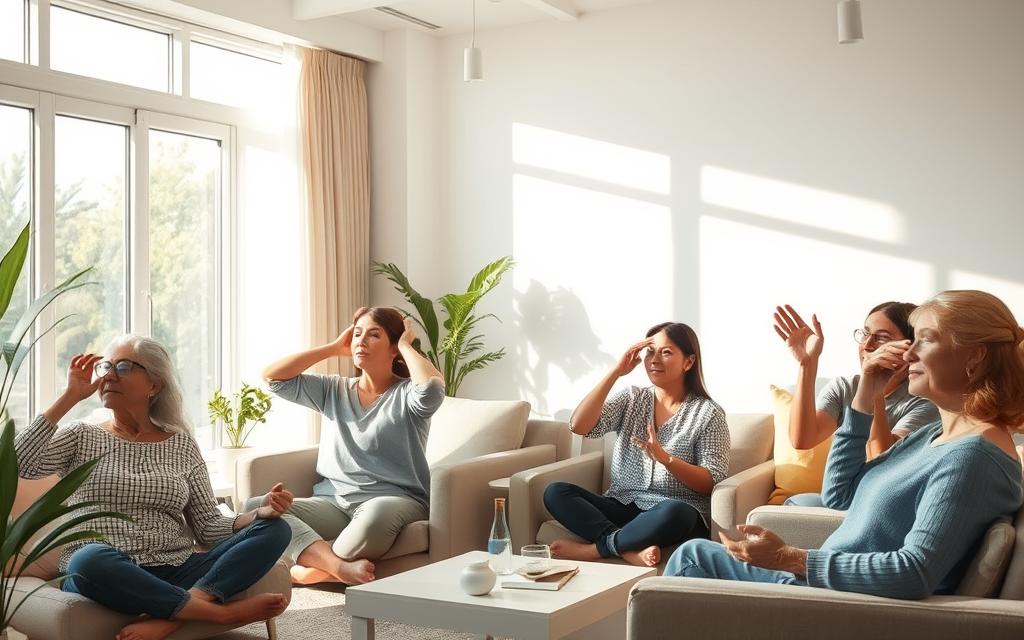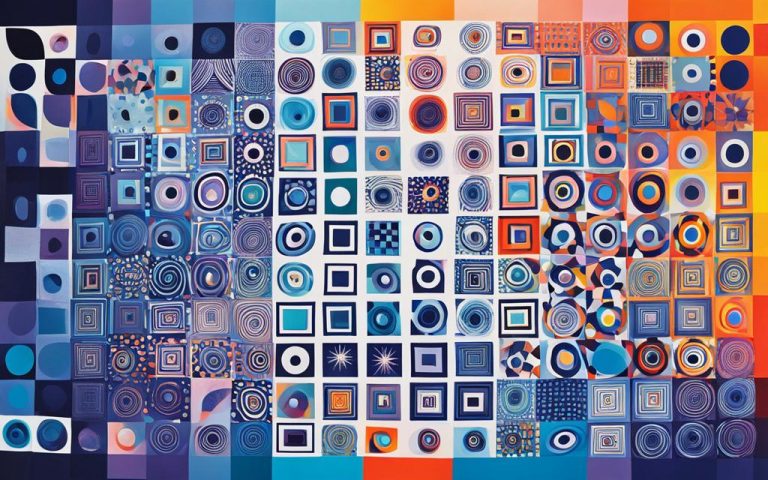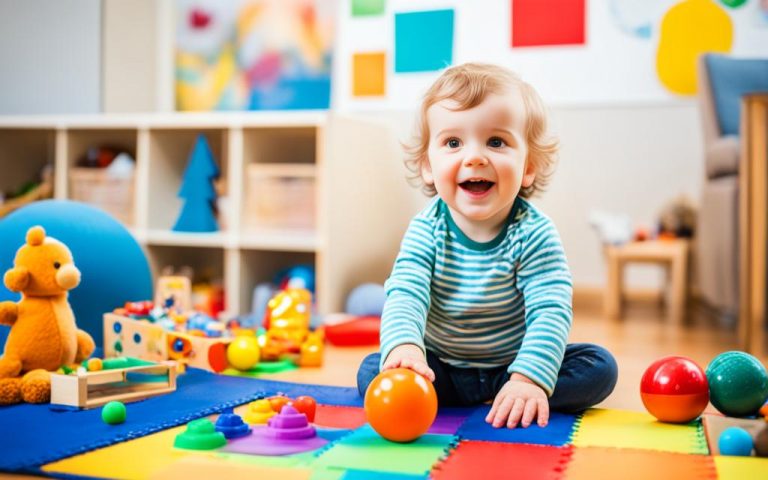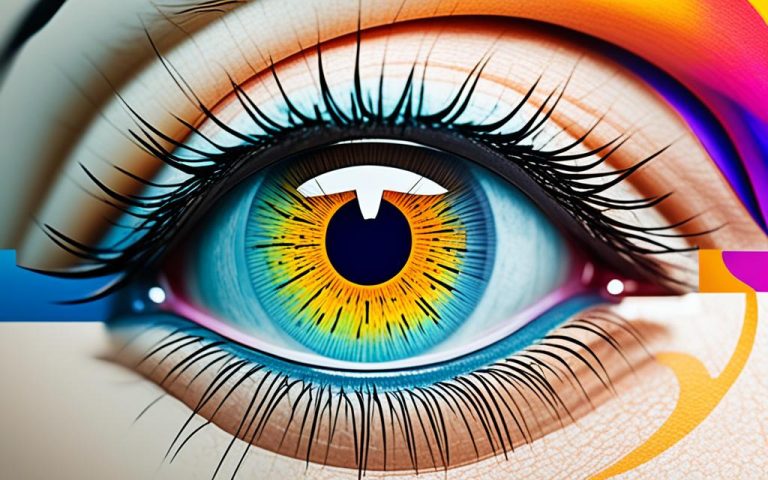Revitalize Your Vision with Eye Care Therapy
Eye care therapy is a new way to boost your vision and help with eye problems. It’s like eye physical therapy, not surgery1. This method helps with eye strain and headaches by improving how your eyes work together2.
This therapy uses exercises to make your eyes work better. It helps with reading and seeing depth clearly23. It’s great for those who have trouble reading or seeing things in depth23.
It’s been very successful in treating lazy eye and crossed eyes1. People see better in school and find reading easier1.
How long and how often you do vision therapy depends on your needs. You might go once or twice a week for 30 to 60 minutes1. The whole treatment can take weeks or months, depending on your progress1.
Always talk to an eye care expert to see if vision therapy is right for you. They can make a plan just for you, based on your vision problems and goals2.
Key Takeaways
- Eye care therapy is a non-invasive treatment for various vision problems
- It improves eye alignment, focusing abilities, and visual perception
- Vision therapy can treat conditions like lazy eye and crossed eyes
- Sessions typically occur weekly and last 30-60 minutes
- Treatment duration varies based on individual needs and progress
- Professional guidance is essential for effective vision therapy
Understanding Eye Care Therapy
Eye care therapy, also known as optometric vision therapy, is a special program. It helps improve how well your eyes and brain work together. This leads to better vision and motor skills.
What is eye care therapy?
It’s a program with exercises and activities for your eyes. These exercises help your eye muscles get stronger. They also improve your focus and how well your eyes and brain work together. People of all ages can benefit from it, and you might see changes in just a few weeks4.
Benefits of vision therapy
Vision therapy has many benefits:
- Enhanced eye coordination
- Improved depth perception
- Better visual processing speed
- Reduced eye strain and fatigue
- Increased reading efficiency
You might start seeing results in a few weeks or it could take up to six months4.
Common conditions treated
Vision therapy helps with many visual problems:
| Condition | Description |
|---|---|
| Amblyopia (lazy eye) | Reduced vision in one eye due to abnormal visual development |
| Strabismus (crossed eyes) | Misalignment of the eyes |
| Convergence insufficiency | Difficulty focusing on near objects |
| Visual processing disorders | Problems interpreting visual information |
For years, vision therapy has helped both kids and adults4. It’s key to remember that over 50% of people with glaucoma don’t know they have it because they don’t show symptoms. This shows why regular eye check-ups and vision therapy are so important5.
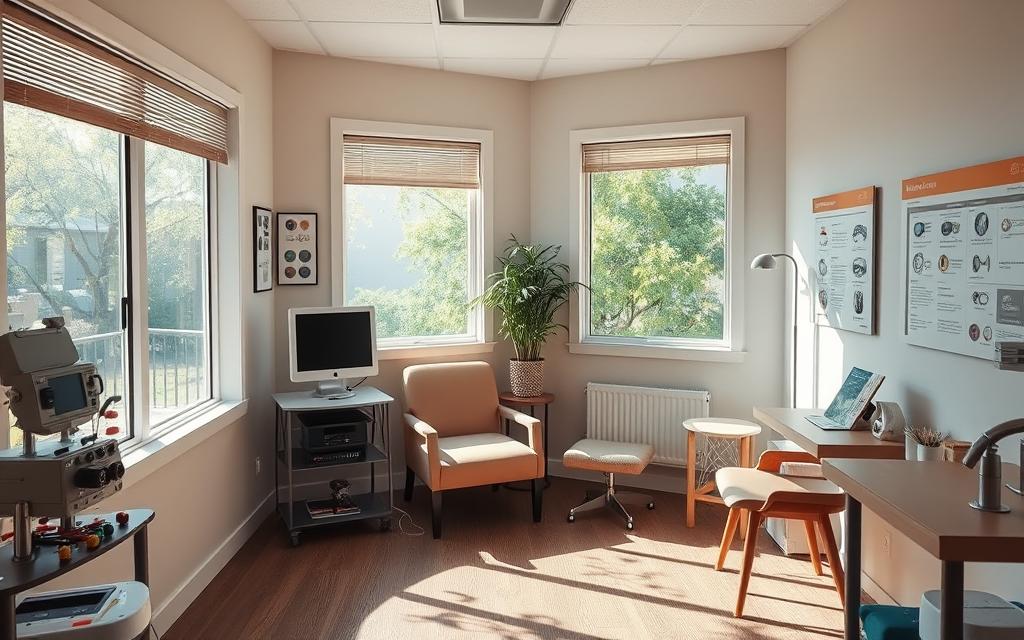
The Science Behind Vision Therapy
Vision therapy uses the idea of neuroplasticity, which means your brain can make new connections at any time. It helps improve how your eyes and brain work together. This makes your vision better and how you understand what you see.
Studies on vision therapy have given mixed results. Some studies show it helps with certain problems, but others don’t find much benefit. For example, research hasn’t always backed up the use of behavioral vision therapy6.
Visual-cognitive training is a part of vision therapy that aims to improve how your eyes work together and move. Surprisingly, many studies have found that kids with dyslexia often have normal eye coordination and movement6. This challenges the idea that vision problems cause reading issues.
Neuro-optometric rehabilitation is another part of vision therapy that looks promising. For example, eye exercises given by eye doctors can help fix eye movement issues. These issues can cause blurry vision, double vision, or headaches6.
Recent studies have looked into how well vision therapy works for different issues. A study found that special glasses helped kids with convergence insufficiency7. Another study showed that vision therapy helped adults with amblyopia, along with eye patching therapy7.
| Condition | Vision Therapy Effectiveness | Study Type |
|---|---|---|
| Convergence Insufficiency | Positive effects with base-in prism reading glasses | Randomized Clinical Trial |
| Anisometropic Amblyopia | Effective as adjunct to occlusion therapy | Clinical Study |
| Intermittent Exotropia | Potential benefits observed | Case Series |
These studies show that vision therapy might help with some issues, but it’s not the same for everyone. We need more research to understand how it affects different vision problems.
Eye Care Therapy Techniques and Exercises
Eye care therapy uses various techniques to boost vision and ease eye strain. These exercises are key to vision recovery and improving how we see things.
Palming for Eye Relaxation
Palming is a simple yet powerful eye exercise. Just cover your closed eyes with your warm palms for a few minutes. It relaxes eye muscles and cuts down on fatigue, giving your eyes a nice break.
Blinking Exercises
Conscious blinking is vital for eye health. It keeps the tear film in check and gets the oil glands in your eyelids working. Try blinking on purpose throughout the day, especially when you’re on a screen8.
Pencil Push-ups
Pencil push-ups are great for improving eye focus. Hold a pencil out in front of you and slowly move it towards your nose, keeping your eyes on it. Do this for 15 minutes a day, 5 days a week, for best results9.
Near and Far Focus Training
This exercise helps your eyes switch between focusing on close and far objects. Look at something 10 to 20 meters away, then at your thumb close up. Do this 5 times to make your focusing better9.
Other good eye exercises include tracing figure eights with your eyes and using the Brock String for eye alignment. Remember the 20/20/20 rule: every 20 minutes, look at something 20 feet away for 20 seconds to fight digital eye strain98.
| Exercise | Duration | Frequency | Benefits |
|---|---|---|---|
| Pencil Push-ups | 15 minutes | 5 days/week | Improves convergence |
| Figure 8 | Few minutes each direction | Daily | Enhances eye movement control |
| 20/20/20 Rule | 20 seconds | Every 20 minutes | Reduces digital eye strain |
| Near & Far Focusing | 5 repetitions | Daily | Improves focus flexibility |
For tailored advice on these exercises and vision therapy, talk to an eye care expert. Many eye doctors in the U.S. offer vision therapy to boost your visual skills and eye health8.
Visual Skills Enhanced Through Therapy
Eye care therapy is a great way to boost your visual abilities. It helps children, adults, and athletes by developing skills that make learning, reading, and focusing easier10.
Targeted exercises can improve key visual skills:
- Eye tracking for smooth object following
- Eye teaming for efficient binocular vision
- Focusing ability for clear vision at various distances
- Visual information processing for interpreting visual data
Vision therapy is great for common eye issues like amblyopia (lazy eye) and strabismus (crossed eyes)11. It also helps with focusing, convergence insufficiency, and tracking problems11.
Athletes see big gains in hand-eye coordination, depth perception, and reaction time with vision therapy11. These improvements help in sports and everyday tasks like sewing, reading, and writing10.
Students benefit from vision therapy too. It makes reading, understanding, and processing visual information better, which boosts grades11. You might start seeing changes after just a few weeks of practice10.
| Skill Enhanced | Benefits |
|---|---|
| Depth Perception | Improved sports performance and reading ability |
| Hand-Eye Coordination | Enhanced sewing, reading, writing, and sports skills |
| Visual Processing | Better academic performance and learning efficiency |
Strengthening these visual skills leads to big improvements in daily tasks, school work, and overall comfort with your vision.
The Role of Optometric Vision Therapy
Optometric vision therapy is key in making vision better and fixing vision problems. It’s a set of activities aimed at improving how we see and solving vision issues12.
Professional Guidance and Assessment
First, you’ll get a detailed eye check-up and a look at your visual skills. This step finds out what visual problems you have and helps create a plan just for you13. Experts in vision therapy and related fields do these checks to make sure you get the right help.
Customized Treatment Plans
After the check-up, a special plan is made for you. It might include eye exercises, tasks to improve scanning, lens and prism therapy, and computer programs12. The aim is to boost your eye tracking, focusing, seeing depth, and how fast you process visual information.
Monitoring Progress and Adjusting Techniques
Your progress is checked often, and the therapy plan can change if needed. How long you’ll need vision therapy depends on your vision problems and how well you’re doing12. This keeps the therapy working well and adapting to your changing needs.
Optometric vision therapy can make seeing more comfortable, improve eye coordination, and make reading and learning easier12. It’s great for issues like amblyopia, strabismus, and convergence insufficiency. It helps you see better and live a fuller life.
Neuro-Optometric Rehabilitation
Neuro-optometric rehabilitation helps with vision problems caused by brain injuries or neurological conditions. It uses a mix of neurology, optometry, and occupational therapy. This approach is for people with stroke, traumatic brain injury, or multiple sclerosis14.
The main aim is to train your visual system and connect it better with your brain. This improves how you process visual information and your sense of space. Experts can fix issues like double vision, tracking problems, and losing part of your visual field14.
Visual-cognitive training is a big part of this therapy. It helps your brain better understand and make sense of what you see. This is especially helpful for those with brain injuries, cerebral palsy, or multiple sclerosis1415.
“Early diagnosis in neuro-optometric rehabilitation leads to more efficient treatment outcomes.”
The therapy might use special lenses, prisms, and exercises. These tools help your brain and eyes work better together. How long you need therapy depends on your injury’s severity, from weeks to years14.
Many times, eye problems are missed when treating a brain injury. That’s why it’s key to have special vision tests in neuro-optometric rehabilitation15.
| Condition | Visual Symptoms | Rehabilitation Focus |
|---|---|---|
| Traumatic Brain Injury | Double vision, tracking problems | Eye coordination exercises |
| Stroke | Visual field loss, visual neglect | Visual field expansion training |
| Multiple Sclerosis | Blurred vision, eye movement issues | Oculomotor training |
Fixing these visual issues is key to improving your life and making you more independent.
Binocular Vision Therapy Explained
Binocular vision therapy is a special treatment that helps improve how your eyes work together. It tackles issues that can make everyday tasks hard, like reading or causing headaches.
Improving Eye Coordination
How we see the world depends a lot on our eye coordination. This therapy trains your eyes to work as a team. If your eyes don’t work well together, you might see blurry vision, double vision, or feel sensitive to light16.
These problems can lead to headaches and discomfort in your head and neck. This can make it hard to focus and be productive16.
Treating Convergence Insufficiency
Convergence insufficiency is when your eyes have trouble focusing on close objects. It can cause eye strain, make reading tiring, and make it hard to concentrate17. But, vision therapy can help fix this issue.
It’s more effective than surgery or glasses in treating convergence insufficiency18.
Enhancing Depth Perception
Being able to judge distances is important for many activities, like driving or playing sports. If your binocular vision isn’t working right, it can make judging distances hard. This can lead to trouble with throwing or catching things16.
Special exercises and techniques in binocular vision therapy can improve your depth perception. This makes your overall vision better.
It’s important to act fast, especially for kids, because their brains can change easily17. If you see your eyes rubbing a lot, tilting your head, or having trouble with reading, get a professional check-up for binocular vision problems17.
Getting the right diagnosis and treatment can really make a big difference in your life and how comfortable you feel.
Visual Information Processing Training
Visual information processing is key in eye care therapy. It helps your brain better understand and use visual data. This training boosts skills like visual memory, spatial awareness, and making visual distinctions.
Kids with visual processing issues may find school, sports, and social life tough, even with perfect vision19. They might have trouble remembering words, mix up numbers or letters, and write illegibly19. These problems can hit kids with reading issues, dyslexia, and ADD/ADHD hard20.
Visual-cognitive training exercises work on improving various visual skills:
- Visual closure
- Visual discrimination
- Visual figure-ground
- Visual form constancy
- Visual memory
- Visual sequential memory
A full vision therapy program can really boost a child’s visual skills with specific eye exercises20. This helps kids do better in school and tackle reading, spelling, and math challenges1920.
| VIP Skill | Description | Example Exercise |
|---|---|---|
| Visual Closure | Recognizing objects from incomplete visual information | Completing partially drawn pictures |
| Visual Discrimination | Identifying differences between similar objects | Spot-the-difference puzzles |
| Visual Memory | Recalling visual information after a brief exposure | Memorizing and recreating patterns |
Adding these exercises to your routine can make your brain better at handling and understanding visual info.
Eye Care Therapy for Children vs. Adults
Vision therapy helps both kids and adults, but it’s tailored for their age. For kids, starting early can stop vision problems later on.
Kids often need vision therapy for issues like lazy eye or eyes that don’t line up right2122. Therapy for them is fun and uses games. This makes learning easier.
Adults might need vision therapy for work or after a head injury. Their therapy is more complex and requires effort. It helps with issues like eye strain, brain injury effects, and vision problems after a stroke21.
| Aspect | Children | Adults |
|---|---|---|
| Focus | Developmental issues | Workplace demands, injury recovery |
| Approach | Play-based activities | Sophisticated exercises |
| Common Conditions | Amblyopia, strabismus | Convergence insufficiency, TBI |
| Neuroplasticity | High | Present, but lower |
Both kids and adults can get better vision skills from therapy. Adults can improve their eye-brain connection and vision after surgery21. It’s important for kids to have regular eye checks to catch problems early22.
Integrating Technology in Vision Therapy
Vision therapy has grown with new technology, offering solutions for many visual issues. These tools make treatment more effective and fun for patients.
Computer-aided vision exercises
Computer-aided vision exercises have changed how we train our vision. These programs let patients practice at home, speeding up progress. The market for augmented and virtual reality contact lenses is expected to jump from $15 million in 2021 to $71.15 million by 203123.
Virtual reality applications
Virtual reality (VR) is changing vision therapy. VR headsets let patients practice in realistic scenarios. The VR market in healthcare is set to grow from $3.11 billion in 2023 to $25.22 billion by 2030, growing fast23.
Eye-tracking software
Eye-tracking software is key in modern vision therapy. It tracks eye movements to pinpoint areas for improvement. The RightEye system can diagnose eye and brain health issues in just five minutes, offering insights for better athletic performance24.
These technologies make therapy more fun and give detailed data for custom treatment plans. Opticians offering vision therapy see more trust from clients, as people learn how it helps with focus and memory25.
| Technology | Application | Benefits |
|---|---|---|
| Computer-aided exercises | Visual-cognitive training | Customizable, at-home practice |
| Virtual Reality | Immersive visual skill practice | Realistic scenarios, enhanced engagement |
| Eye-tracking software | Precise eye movement analysis | Targeted improvement, progress tracking |
The 20-20-20 Rule and Digital Eye Strain
In today’s world, staring at screens all day can strain our eyes. Up to 97% of people who use digital devices often suffer from this strain. It can cause blurry vision, dry eyes, and headaches26. With more people working from home, this problem is getting worse27.
The 20-20-20 rule is a simple way to fight eye strain. It tells us to look away from screens for 20 seconds every 20 minutes at a distance of 20 feet. This helps relax eye muscles and keeps eyes moist.
But, research on the 20-20-20 rule is mixed. A study found it didn’t help with eye strain or improve work performance27. Another study with 35 people showed it didn’t make a big difference, but it did help with eye coordination a bit26.
Not many people know about this rule. A study in Peru found only 13.1% of nursing students knew it. In India, 8.8% of people followed it26. This shows we need to teach more about preventing eye strain.
The 20-20-20 rule isn’t the only solution. Vision therapy offers better ways to deal with eye strain. Experts suggest proper screen setup, anti-glare glasses, and blinking exercises to ease symptoms27. Getting your eyes checked regularly is key to fixing eye problems caused by screens.
As we use more digital devices, taking care of our eyes is crucial. Using vision therapy and getting regular eye exams can lessen eye strain. This keeps our vision clear and comfortable.
Combining Eye Care Therapy with Traditional Treatments
Eye care has changed a lot since the 1990s. Now, we focus on treating inflammation in dry eye disease (DED). The approval of Restasis in 2003 started the Age of Investment. This brought new therapies and treatments you can get in an office28. Now, you can use vision therapy and traditional treatments together for the best results.
Vision therapy helps kids and adults with reading and attention issues, and problems with how the brain processes what we see. It offers personalized plans with exercises to improve reading and learning29. When you add this to glasses or contact lenses, you fix both how your eyes see and how your brain uses the information.
New eye care options include FDA-approved treatments like intense pulsed light (IPL) for dry eye. Low-level light therapy (LLLT) also helps with dry eye symptoms30. Using these new treatments with vision therapy and traditional care gives you a full solution for eye problems. It makes your vision better and more comfortable overall.
FAQ
What is eye care therapy?
Eye care therapy, also known as vision therapy, is a type of physical therapy for the eyes. It uses eye exercises to improve visual skills and treat various eye conditions.
What are the benefits of vision therapy?
Vision therapy helps optimize visual skills, improve eye alignment, and enhance focusing abilities.
What are some common conditions treated with eye care therapy?
It treats strabismus (eye turn), amblyopia (lazy eye), saccadic dysfunction (eye tracking), and convergence insufficiency (eye teaming).
What techniques and exercises are used in eye care therapy?
Techniques include palming, blinking exercises, pencil push-ups, near and far focus training, figure eights for eye tracking, and the Brock String for eye alignment and focusing.
What visual skills are enhanced through eye care therapy?
It improves eye tracking, eye teaming, focusing, visual processing, peripheral awareness, depth perception, and visual-motor integration.
What is the role of optometric vision therapy?
It’s a structured program of visual activities to improve visual function. It includes an eye exam, visual skills assessment, a customized treatment plan, professional supervision, and regular progress checks.
What is neuro-optometric rehabilitation?
It’s a specialized vision therapy for visual problems from neurological conditions or brain injuries. It combines neurology, optometry, and occupational therapy to treat visual dysfunctions from stroke, traumatic brain injury, or multiple sclerosis.
What is binocular vision therapy?
It improves how both eyes work together. It treats convergence insufficiency and enhances depth perception and reduces eye strain.
What is visual information processing training?
It’s part of eye care therapy that improves how the brain uses visual information. It focuses on visual memory, spatial relationships, and visual discrimination.
How does eye care therapy differ for children and adults?
For kids, it often deals with developmental vision problems and learning-related issues, using play-based activities. For adults, it focuses on workplace demands, digital eye strain, or recovering from head injuries, needing more effort and complex exercises.
How is technology integrated into vision therapy?
Technology like computer-aided exercises, virtual reality apps, and eye-tracking software is used to make therapy more effective, engaging, and to track progress.
What is the 20-20-20 rule for digital eye strain?
This rule suggests looking at something 20 feet away for 20 seconds every 20 minutes of screen time. It helps reduce eye fatigue and keep eyes moist.
Can eye care therapy be combined with traditional vision treatments?
Yes, combining eye care therapy with traditional treatments like glasses or contact lenses provides a comprehensive approach to visual issues.
Source Links
- https://www.samyakeyecare.com/how-vision-therapy-can-improve-your-eyesight/ – How Vision Therapy Can Improve Your Eyesight – Samyak
- https://kraffeye.com/blog/8-easy-eye-exercises-to-improve-vision-techniques-and-tips – 8 Easy Eye Exercises to Improve Vision: Techniques and Tips | Kraff Eye Institute
- https://www.webmd.com/eye-health/eye-exercises – Exercises for Your Eyes
- https://www.optometrists.org/vision-therapy/guide-to-vision-therapy/what-is-vision-therapy/ – What Is Vision Therapy?
- https://www.suburbaneyecare.com/ – Homepage
- https://aapos.org/glossary/vision-therapy – Vision Therapy – American Association for Pediatric Ophthalmology and Strabismus
- https://www.ncbi.nlm.nih.gov/pmc/articles/PMC9777217/ – Vision Therapy: A Primer and Caution for Pediatricians
- https://www.clarksoneyecare.com/eye-care-resources/4-vision-therapy-exercises-you-can-try-at-home – Vision Therapy Exercises to Try at Home | Clarkson Eyecare
- https://advanceeyecarecenter.com/8-vision-therapy-exercises-you-can-do-at-home/ – 8 Vision Therapy Exercises To Do At Home | Regina
- https://www.dryeyecenterofalabama.com/blog/what-skills-can-be-developed-through-vision-therapy.html – What Skills Can Be Developed Through Vision Therapy?
- https://www.2020fresno.com/blog/exploring-the-benefits-of-vision-therapy.html – Exploring the Benefits of Vision Therapy
- https://wilmingtonfamilyeyecare.com/understanding-optometric-vision-therapy-and-its-uses-in-eyecare/ – Understanding Optometric Vision Therapy and Its Uses in Eyecare
- https://www.shortpumpfamilyeyecare.com/your-eye-health/childrens-vision/vision-therapy-for-children/ – Vision Therapy for Children
- https://www.impactvisiontherapy.com/eye-care-services/neuro-optometric-rehabilitation/neuro-optometric-rehabilitation-faqs/ – Neuro-Optometric Rehabilitation — FAQs
- https://noravisionrehab.org/patients-caregivers/what-is-neuro-optometric-rehabilitation – What is Neuro-Optometric Rehabilitation? | Neuro-Optometric Rehabilitation Association
- https://my.clevelandclinic.org/health/diseases/binocular-vision-dysfunction-bvd – Both Eyes Open: How Binocular Vision Dysfunction Affects How You See the World
- https://bellevuesec.com/types-of-binocular-vision-dysfunction-treatment/ – Types of Binocular Vision Dysfunction Treatment
- https://doctorbruce.net/vision-therapy/ – Vision Therapy | Northwest Eye Care Professionals
- https://www.optometrists.org/vision-therapy/guide-vision-and-learning-difficulties/guide-to-visual-information-processing/ – Guide to Visual Information Processing
- https://www.optometrists.org/vision-therapy/guide-vision-and-learning-difficulties/guide-to-visual-information-processing/signs-of-visual-processing-information-dysfunction/what-is-visual-information-processing/ – What is Visual Information Processing?
- https://www.goldeneyeclinic.net/vision-therapy-treatments-teens-vs-adults/ – Vision Therapy Treatments: Teens vs Adults
- https://www.webmd.com/eye-health/what-to-know-about-vision-therapy – What to Know About Vision Therapy
- https://ventionteams.com/healthtech/virtual-reality/vision-therapy – Virtual Reality for Vision Therapy: Pioneering Digital Eye Treatments
- https://accenteyes.com/vision-therapy-technology/ – Vision Technology | New Eye Technology | Eye Care Tech
- https://dicopt.com/en/transforma-optometria-terapia-visual/ – Transformation of optometry: the power of vision therapy – DICOPT | lazy eye treatment
- https://modernod.com/articles/2023-july-aug/myth-busting-the-202020-rule – Myth-Busting the 20/20/20 Rule – Modern Optometry
- https://www.optometryadvisor.com/features/digital-eye-strain-may-not-be-solved-by-the-20-20-20-rule/ – Digital Eye Strain: Another Look at the 20-20-20 Rule
- https://www.healio.com/news/ophthalmology/20240415/the-era-of-and-combination-therapy-arrives – The Era of ‘And’: Combination therapy arrives
- https://healthclinics.rm.edu/eyeinstitute/vision-therapy-binocular-vision/ – Vision Therapy & Binocular Vision
- https://www.optometrytimes.com/view/new-technologies-in-the-clinic-combining-light-based-therapies-for-the-treatment-of-dry-eye – New technologies in the clinic: Combining light-based therapies for the treatment of dry eye

